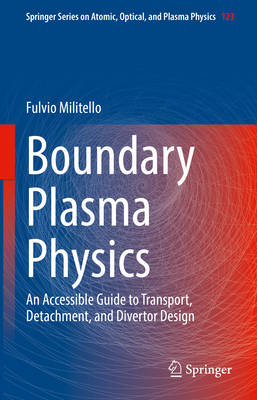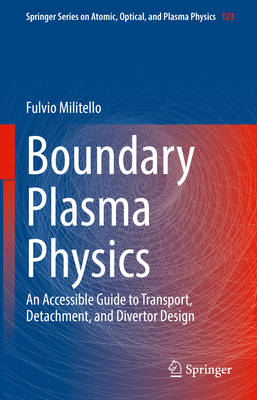
- Retrait gratuit dans votre magasin Club
- 7.000.000 titres dans notre catalogue
- Payer en toute sécurité
- Toujours un magasin près de chez vous
- Retrait gratuit dans votre magasin Club
- 7.000.0000 titres dans notre catalogue
- Payer en toute sécurité
- Toujours un magasin près de chez vous
Boundary Plasma Physics
An Accessible Guide to Transport, Detachment, and Divertor Design
Fulvio MilitelloDescription
1 Introduction
1.1 Essential Elements of Fusion Physics
1.2 The Plasma Exhaust Problem
1.3 Boundary physics at a glance
1.4 Goals and Synopsis .
2 Plasma Equations
2.1 Forces and Dynamics2.2 Kinetic Description
2.2.1 Liouville Equation and Probability Distributions
2.2.2 Boltzmann and Vlasov Equation
2.3 A basic discussion of plasma collision operators
2.3.1 From collisions to collision operators .
2.3.2 Boltzmann's H-theorem, or a short history of irreversibility
2.3.3 Simplifying things: the BGK Operator
2.4 Fluid Description
2.4.1 Density Equation
2.4.2 Momentum Equation
2.4.3 Energy Equation
2.5 Implication of non-relativistic dynamics
2.6 Closures, Orderings and Reduced Models2.6.1 Braginskii equations
2.6.2 MHD
2.6.3 Drift-ordered equations
2.6.4 Geometry in reduced 2D systems
3 Sheath Physics
3.1 The Langmuir (or Debye) sheath
3.2 Debye Shielding
3.3 A quick review of wall models
3.4 Wall with perpendicular magnetic field or non magnetised plasma
3.4.1 Fluid sheath model and existence conditions
3.4.2 Particle fluxes and electrical phenomena in the sheath
3.4.3 Collisional presheath
3.4.4 Kinetic treatment of the sheath3.4.5 Bohm criterion for plasmas with multiple ions
3.4.6 Sheath energy transmission - formerly (and wrongly) known as heat transmission
3.5 Wall with inclined magnetic fields and magnetic pre-sheath
3.5.1 Bohm criterion for shallow angles and magnetic pre-sheath
3.5.2 Electric potential and dependence on the incidence angle
3.5.3 Effect of fluid drifts
3.5.4 Very shallow angles and role of collisions
4 Atomic, Molecular and Plasma-Surface physics
4.1 A few useful concepts and reaction terminology
4.2 Basic model with atomic hydrogen
4.2.1 Electron-Neutrals interactions
4.2.2 Ion-Neutral Interactions
4.2.3 Other interactions between the electrons, ions, and atoms
4.3 Molecular interactions
4.4 Impurities
4.5 Plasma-Surface interactions
4.5.1 Reflection, Trapping and Desorption
4.5.2 Wall Recycling
4.5.3 Sputtering4.5.4 Electron emission
5 Basic Exhaust Concepts
5.1 Magnetic Geometry and its connection with the boundary plasma
5.2 Protecting the Plasma Facing Structures
5.3 Elementary estimates of Scrape-Off Layer Width
5.4 Simple Geometrical Effects - Flux Expansion and Tile Tilting
5.4.1 Poloidal and Toroidal flux expansion
5.4.2 Target tilting
5.4.3 Total flux expansion and magnetic projection of the areas
5.4.4 Further observations on the geometrical effects5.5 Divertor Regimes: the Two Point Model
5.5.1 Derivation of the two point model
5.5.2 General solutions of the two point model
5.5.3 Collisionality and its role in the two point model
5.5.4 Applications of the two point model: divertor regimes
5.5.5 Extended two point model
5.6 Flux formulation and parallel profiles in the boundary plasma
5.6.1 Neutrals and particle sources
5.6.2 Particle flux
5.6.3 Energy flux and temperature profile
5.6.4 Target conditions
5.6.5 Upstream conditions
5.6.6 Mach number, velocity and density profiles
5.6.7 Electric potential
5.7 Divertor asymmetry in low to intermediate collisionality
6 Radiation and Detachment
6.1 Plasma/neutral processes at large collisionality and low tem
Spécifications
Parties prenantes
- Auteur(s) :
- Editeur:
Contenu
- Nombre de pages :
- 522
- Langue:
- Anglais
- Collection :
- Tome:
- n° 123
Caractéristiques
- EAN:
- 9783031173387
- Date de parution :
- 07-12-22
- Format:
- Livre relié
- Format numérique:
- Genaaid
- Dimensions :
- 156 mm x 234 mm
- Poids :
- 925 g

Les avis
Nous publions uniquement les avis qui respectent les conditions requises. Consultez nos conditions pour les avis.






